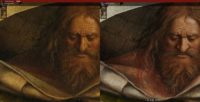 As part of their 2010 agreement to fund the restoration of the Ghent Altarpiece, the Getty Foundation’s Panel Painting Initiative stipulated that the entire process be documented and photographed in dizzyingly high resolution and every detail from dendrochronology reports to pictures of a few inches worth of newly cleaned paint be uploaded to a dedicated website. Closer to Van Eyck: Rediscovering the Ghent Altarpiece is a masterpiece of online information sharing, a worthy helpmeet, technologically speaking, to the massive oak panel polyptych painted in the first half of the 15th century by Hubert Van Eyck and his brother Jan that is an icon of Belgium, Early Netherlandish art and an art historical watershed.
As part of their 2010 agreement to fund the restoration of the Ghent Altarpiece, the Getty Foundation’s Panel Painting Initiative stipulated that the entire process be documented and photographed in dizzyingly high resolution and every detail from dendrochronology reports to pictures of a few inches worth of newly cleaned paint be uploaded to a dedicated website. Closer to Van Eyck: Rediscovering the Ghent Altarpiece is a masterpiece of online information sharing, a worthy helpmeet, technologically speaking, to the massive oak panel polyptych painted in the first half of the 15th century by Hubert Van Eyck and his brother Jan that is an icon of Belgium, Early Netherlandish art and an art historical watershed.
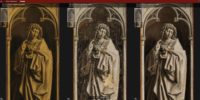 The altarpiece, formally known as The Mystic Lamb of 1432, is in the Cathedral of St. Bavo in Ghent, Belgium, and has remained on public view during years of restoration, study, research and documentation. Not a great view, mind you, what with all the people and stuff going on, but they built a protective transparent enclosure to give visitors a once-in-a-lifetime chance to see some of the greatest people in their fields, from carpenters to retouchers, work on one of the world’s greatest pieces of art. The creation of the Closer to Van Eyck site with its dense database of information and unparalleled pictorial documentation made it possible for the whole world to see with their naked eyes things that were not only the purview of a select group of professionals, but that even said professionals could not see with their naked eyes.
The altarpiece, formally known as The Mystic Lamb of 1432, is in the Cathedral of St. Bavo in Ghent, Belgium, and has remained on public view during years of restoration, study, research and documentation. Not a great view, mind you, what with all the people and stuff going on, but they built a protective transparent enclosure to give visitors a once-in-a-lifetime chance to see some of the greatest people in their fields, from carpenters to retouchers, work on one of the world’s greatest pieces of art. The creation of the Closer to Van Eyck site with its dense database of information and unparalleled pictorial documentation made it possible for the whole world to see with their naked eyes things that were not only the purview of a select group of professionals, but that even said professionals could not see with their naked eyes.
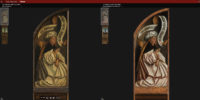 When I first discovered the website in 2012, I spent a whole weekend immersed in its Chutes and Ladders-like maze of fascinating content. I checked it regularly for years afterwards, but my interest eventually petered off when I found it wasn’t getting fresh updates. I saw yesterday when writing about the Caravaggio exhibition that the Getty Foundation and the Royal Institute for Cultural Heritage in Brussels had big news regarding Closer to Van Eyck. The site has had a major update and now has brand new photographs in nosebleed high res of the polyptych at various stages in the conservation process. There are more technical images available — it started out with just X-rays, now that’s just scratching the surface of their offerings — and a freaking cool feature that allows you to compare several views of the panels at the same time.
When I first discovered the website in 2012, I spent a whole weekend immersed in its Chutes and Ladders-like maze of fascinating content. I checked it regularly for years afterwards, but my interest eventually petered off when I found it wasn’t getting fresh updates. I saw yesterday when writing about the Caravaggio exhibition that the Getty Foundation and the Royal Institute for Cultural Heritage in Brussels had big news regarding Closer to Van Eyck. The site has had a major update and now has brand new photographs in nosebleed high res of the polyptych at various stages in the conservation process. There are more technical images available — it started out with just X-rays, now that’s just scratching the surface of their offerings — and a freaking cool feature that allows you to compare several views of the panels at the same time.
The altarpiece was painstakingly recorded at every step of the conservation process through state-of-the-art photographic and scientific documentation. Thanks to the Royal Institute for Cultural Heritage’s imaging team, digital processing and design led by Frederik Temmermans of Universum Digitalis and the Vrije Universiteit Brussels, and imec’s Department of Electronics and Informatics, the altarpiece can now be viewed online in visible light, infrared, infrared reflectograph, and X-radiograph, with sharper and higher resolution images than ever before. Visitors to the site can now also adjust a timeline to view key moments in the conservation process, and have access to simultaneous viewing of images before, during, and after conservation. Users can zoom in even closer on details of the painting, exploring microscopic views of the work in 100 billion pixels. […]
“We are proud and pleased to now also offer unparalleled access to the results of the first stage of the restoration of the Ghent Altarpiece,” says Dr. Ron Spronk, professor of Art History at the Department of Art History and Art Conservation at Queen’s University in Kingston, Ontario, Canada and Radboud University in Nijmegen, the Netherlands, who initiated and coordinated Closer to Van Eyck. “Our site provides images and research materials of unprecedented quality and scope, both on and below the paint surface that will serve both specialists and general audiences for many years to come. We truly have come much, much closer to Van Eyck.”
Not least because they discovered that the vast majority of Van Eyck’s original brushwork had been overpainted, more than 70% of it, so most of what people have been seen of the Ghent Altarpiece wasn’t Van Eyck’s paint at all. Much of the conservation work done thus far was dedicated to removing as much as the overpaint as possible to reveal the artist’s true hand without damaging the delicate original paint layers beneath.
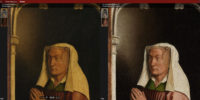 This website is unbelievable. It’s captures all my favorite things: technology in aid of cultural patrimony, specialized skills being taught to a new generation, rich content clearly displayed for all to enjoy without firewalls or payment, and good Ghent almighty praise be to the massive photographs. The weekend is over, but you might need to take a personal day off work so you can have all the time you need to get microscope-close to Jan Van Eyck.
This website is unbelievable. It’s captures all my favorite things: technology in aid of cultural patrimony, specialized skills being taught to a new generation, rich content clearly displayed for all to enjoy without firewalls or payment, and good Ghent almighty praise be to the massive photographs. The weekend is over, but you might need to take a personal day off work so you can have all the time you need to get microscope-close to Jan Van Eyck.
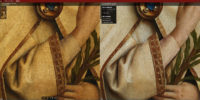 I would suggest you start here with a tour of the site to get a feel for the layout and organization from their very brief and clear video summaries, then bounce around the menu climbing ladders and falling down chutes. Stock up on water and snacks because you won’t be budging from your seat for hours.
I would suggest you start here with a tour of the site to get a feel for the layout and organization from their very brief and clear video summaries, then bounce around the menu climbing ladders and falling down chutes. Stock up on water and snacks because you won’t be budging from your seat for hours.